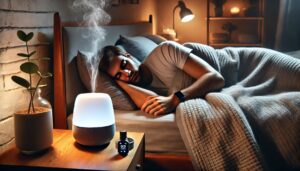In today’s fast-paced world, achieving quality sleep has become increasingly challenging. With distractions ranging from buzzing smartphones to external noises, many people struggle to fall asleep or stay asleep throughout the night. This is where the concept of white noise and sleep sounds enters the scene, offering a simple yet effective solution to improve sleep quality.
What Is White Noise?
White noise is a consistent sound that masks other noises. It contains equal power across all frequencies, creating a soothing auditory backdrop. Think of it as the static noise on a TV or radio. While it might seem counterintuitive to add sound to your environment to achieve silence, white noise works by blending disruptive sounds into the background.
Other types of noise often categorized by color include:
- Pink Noise: A deeper sound compared to white noise, often resembling the rustling of leaves or steady rain.
- Brown Noise: A bass-heavy sound, similar to distant thunder or a waterfall.
Benefits of White Noise for Sleep
Using white noise for sleep isn’t just a trend—it’s a science-backed method that has helped millions improve their rest. Here are some of the top benefits:
1. Blocks Distractions
External noises such as traffic, snoring, or household activities can interrupt your sleep cycle. White noise acts as a buffer, masking these disruptive sounds and creating a stable auditory environment.
2. Promotes Relaxation
The consistent and soothing sound of white noise helps calm the mind. It creates an environment conducive to relaxation, making it easier to drift off.
3. Supports Deeper Sleep
Research has shown that white noise can enhance sleep depth. It helps stabilize the auditory environment, reducing the chances of waking up due to sudden changes in noise levels.
4. Improves Focus for Light Sleepers
Light sleepers often wake up from even the faintest disturbances. White noise creates a sound cocoon that ensures such disruptions are minimized.
Types of Sleep Sounds
Apart from white noise, several other sound categories can improve sleep. These include:
1. Nature Sounds
Sounds like rain, ocean waves, or chirping crickets mimic natural environments, promoting relaxation and aiding sleep.
2. Instrumental Music
Soft, instrumental tracks without lyrics can help calm the mind. Classical or ambient music is particularly effective.
3. ASMR (Autonomous Sensory Meridian Response)
Whispering, tapping, or other gentle sounds trigger a tingling sensation in some people, which can be relaxing and sleep-inducing.
4. Binaural Beats
These sounds use different frequencies in each ear to create a calming effect. Studies suggest binaural beats may improve sleep quality.
Choosing the Right White Noise or Sleep Sound
With so many options available, finding the right sound for your needs can feel overwhelming. Consider these factors:
1. Preference
Choose a sound you find pleasant and soothing. Experiment with different types of white noise, nature sounds, or music to discover what works best for you.
2. Purpose
If you’re using sounds to drown out noise, white noise might be your best bet. If relaxation is your goal, nature sounds or soft music could be more effective.
3. Sound Quality
Invest in a high-quality sound machine or app to ensure clarity. Distorted or harsh sounds can have the opposite effect, disrupting sleep.
How to Use White Noise for Better Sleep
Using white noise or sleep sounds effectively requires a few considerations:
1. Find the Right Volume
Keep the volume at a comfortable level. It should be loud enough to mask external noise but not so loud that it’s distracting.
2. Choose a Reliable Source
Sound machines, smartphone apps, or even YouTube channels offer a wide range of sleep sounds. Ensure the source is reliable and uninterrupted.
3. Create a Routine
Incorporating white noise into your bedtime routine helps signal your body that it’s time to wind down.
4. Combine with Other Sleep Hygiene Practices
For maximum benefits, pair white noise with good sleep hygiene habits like maintaining a consistent sleep schedule, limiting screen time before bed, and creating a comfortable sleep environment.
Popular White Noise Machines and Apps
1. White Noise Machines
- LectroFan: Offers a range of white noise and fan sounds.
- Hatch Restore: Combines soundscapes with a smart alarm clock.
- Marpac Dohm: A classic, fan-based white noise machine.
2. Apps for Sleep Sounds
- Calm: Features guided meditations and sleep stories.
- Headspace: Offers sleep music and mindfulness exercises.
- Rain Rain Sleep Sounds: Specializes in nature and rain sounds.
Common Myths About White Noise
Despite its popularity, some misconceptions surround white noise:
1. “White Noise Causes Dependency”
While many people enjoy using white noise every night, it doesn’t create physical dependency. Instead, it’s a tool that enhances sleep quality.
2. “It’s Only for Babies”
Although white noise is often marketed for infants, it’s equally beneficial for adults.
3. “Any Sound Will Do”
Not all sounds are suitable for sleep. Harsh or erratic noises can be counterproductive.
Final Thoughts: Transform Your Sleep with White Noise
White noise and sleep sounds are more than just a passing trend—they’re a proven method to enhance sleep quality and overall well-being. Whether you’re dealing with noisy neighbors, a snoring partner, or an overactive mind, these sounds offer a simple and effective solution. By incorporating white noise into your nightly routine, you can create a tranquil environment that promotes restorative sleep, leaving you refreshed and ready to take on the day.



